肯定句改为否定句
- 格式:doc
- 大小:30.50 KB
- 文档页数:2
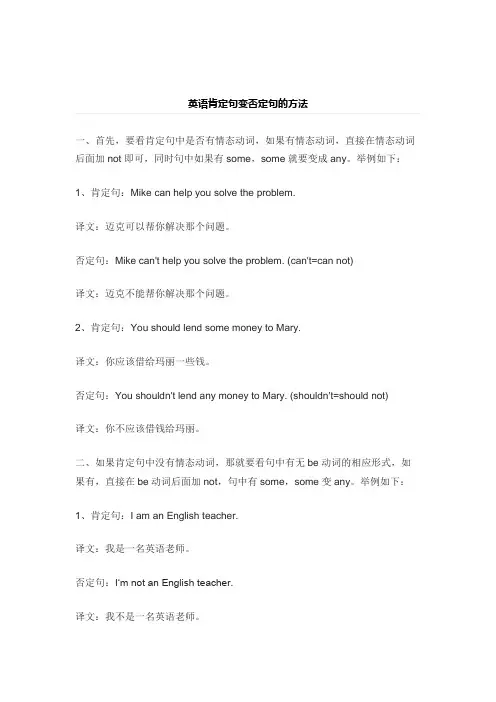
一、首先,要看肯定句中是否有情态动词,如果有情态动词,直接在情态动词后面加not即可,同时句中如果有some,some就要变成any。
举例如下:1、肯定句:Mike can help you solve the problem.译文:迈克可以帮你解决那个问题。
否定句:Mike can't help you solve the problem. (can't=can not)译文:迈克不能帮你解决那个问题。
2、肯定句:You should lend some money to Mary.译文:你应该借给玛丽一些钱。
否定句:You shouldn't lend any money to Mary. (shouldn't=should not)译文:你不应该借钱给玛丽。
二、如果肯定句中没有情态动词,那就要看句中有无be动词的相应形式,如果有,直接在be动词后面加not,句中有some,some变any。
举例如下:1、肯定句:I am an English teacher.译文:我是一名英语老师。
否定句:I‘m not an English teacher.译文:我不是一名英语老师。
2、肯定句:There are some books on the desk.译文:书桌上有一些书。
否定句:There aren't any books on the desk.译文:书桌上没有书。
三、如果肯定句中既没有情态动词,也没有be动词,那么就要用相应的助动词加上not来变换,句中有some,some变any。
举例如下:1、肯定句:She likes helping others.译文:她喜欢帮助别人。
否定句:She doesn't like helping others.译文:她不喜欢帮助别人。
2、肯定句:They have some apples.译文:他们有一些苹果。
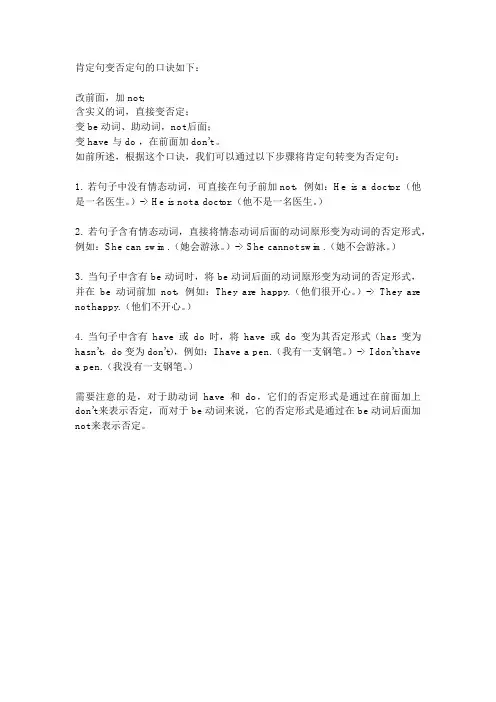
肯定句变否定句的口诀如下:
改前面,加not;
含实义的词,直接变否定;
变be动词、助动词,not后面;
变have 与 do ,在前面加don't 。
如前所述,根据这个口诀,我们可以通过以下步骤将肯定句转变为否定句:
1. 若句子中没有情态动词,可直接在句子前加not,例如:He is a doctor.(他是一名医生。
)-> He is not a doctor.(他不是一名医生。
)
2. 若句子含有情态动词,直接将情态动词后面的动词原形变为动词的否定形式,例如:She can swim.(她会游泳。
)-> She cannot swim.(她不会游泳。
)
3. 当句子中含有be动词时,将be动词后面的动词原形变为动词的否定形式,并在be动词前加not,例如:They are happy.(他们很开心。
)-> They are not happy.(他们不开心。
)
4. 当句子中含有have或do时,将have或do变为其否定形式(has变为hasn't,do变为don't),例如:I have a pen.(我有一支钢笔。
)-> I don't have a pen.(我没有一支钢笔。
)
需要注意的是,对于助动词have和do,它们的否定形式是通过在前面加上don't来表示否定,而对于be动词来说,它的否定形式是通过在be动词后面加not来表示否定。
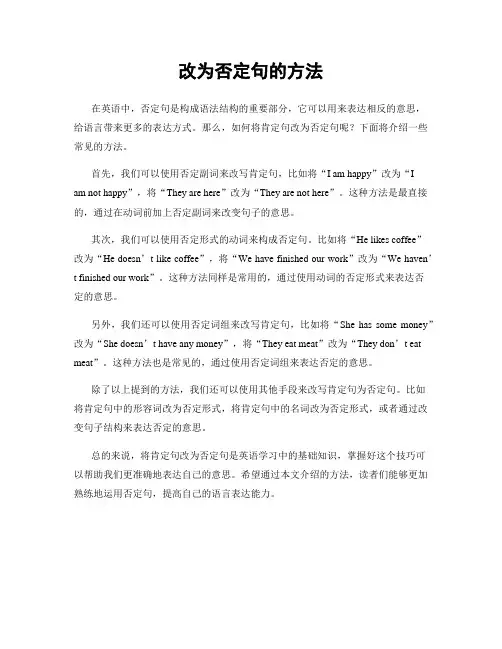
改为否定句的方法
在英语中,否定句是构成语法结构的重要部分,它可以用来表达相反的意思,
给语言带来更多的表达方式。
那么,如何将肯定句改为否定句呢?下面将介绍一些常见的方法。
首先,我们可以使用否定副词来改写肯定句,比如将“I am happy”改为“I
am not happy”,将“They are here”改为“They are not here”。
这种方法是最直接的,通过在动词前加上否定副词来改变句子的意思。
其次,我们可以使用否定形式的动词来构成否定句。
比如将“He likes coffee”
改为“He doesn’t like coffee”,将“We have finished our work”改为“We haven’t finished our work”。
这种方法同样是常用的,通过使用动词的否定形式来表达否
定的意思。
另外,我们还可以使用否定词组来改写肯定句,比如将“She has some money”改为“She doesn’t have any money”,将“They eat meat”改为“They don’t eat meat”。
这种方法也是常见的,通过使用否定词组来表达否定的意思。
除了以上提到的方法,我们还可以使用其他手段来改写肯定句为否定句。
比如
将肯定句中的形容词改为否定形式,将肯定句中的名词改为否定形式,或者通过改变句子结构来表达否定的意思。
总的来说,将肯定句改为否定句是英语学习中的基础知识,掌握好这个技巧可
以帮助我们更准确地表达自己的意思。
希望通过本文介绍的方法,读者们能够更加熟练地运用否定句,提高自己的语言表达能力。
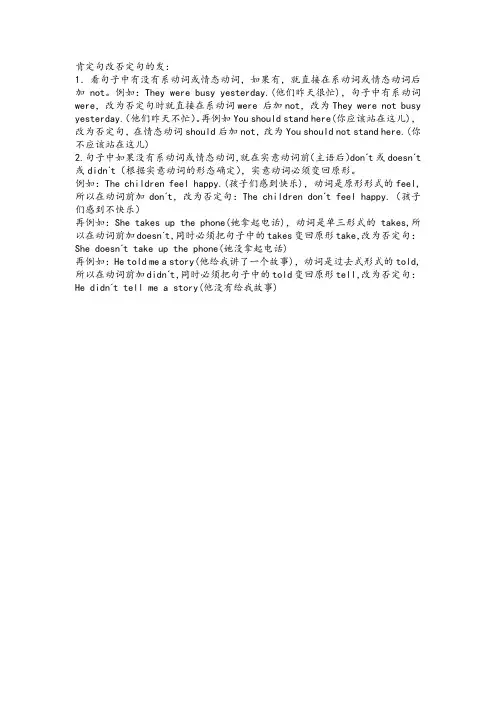
肯定句改否定句的发:
1.看句子中有没有系动词或情态动词,如果有,就直接在系动词或情态动词后加not。
例如:They were busy yesterday.(他们昨天很忙),句子中有系动词were,改为否定句时就直接在系动词were 后加not,改为They were not busy yesterday.(他们昨天不忙)。
再例如You should stand here(你应该站在这儿),改为否定句,在情态动词should后加not,改为You should not stand here.(你不应该站在这儿)
2.句子中如果没有系动词或情态动词,就在实意动词前(主语后)don´t或doesn´t 或didn´t(根据实意动词的形态确定),实意动词必须变回原形。
例如:The children feel happy.(孩子们感到快乐),动词是原形形式的feel,所以在动词前加don´t,改为否定句:The children don´t feel happy.(孩子们感到不快乐)
再例如:She takes up the phone(她拿起电话),动词是单三形式的takes,所以在动词前加doesn´t,同时必须把句子中的takes变回原形take,改为否定句:She doesn´t take up the phone(她没拿起电话)
再例如:He told me a story(他给我讲了一个故事),动词是过去式形式的told,所以在动词前加didn´t,同时必须把句子中的told变回原形tell,改为否定句:He didn´t tell me a story(他没有给我故事)。
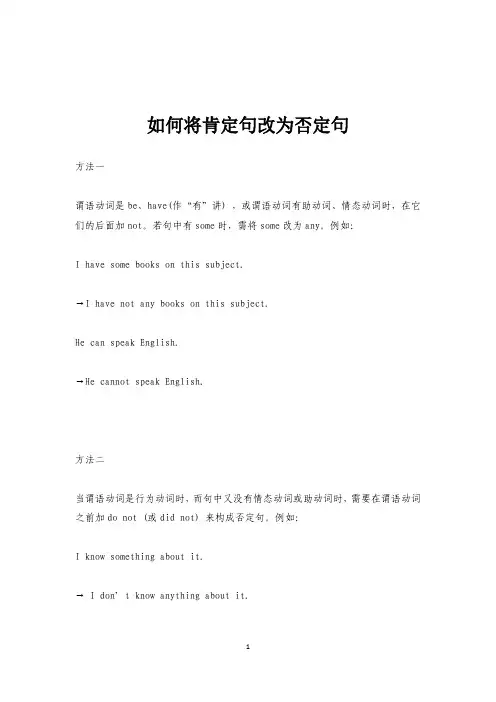
如何将肯定句改为否定句方法一谓语动词是be、have(作“有”讲) ,或谓语动词有助动词、情态动词时,在它们的后面加not。
若句中有some时,需将some改为any。
例如:I have some books on this subject.→I have not any books on this subject.He can speak English.→He cannot speak English.方法二当谓语动词是行为动词时,而句中又没有情态动词或助动词时,需要在谓语动词之前加do not (或did not) 来构成否定句。
例如:I know something about it.→ I don’t know anything about it.方法三否定由think、believe、know等动词引出的宾语从句时,应将主句改为否定形式。
例如:She knows why the train is late.→She doesn’t know why the train is late.方法四祈使句的否定形式是在谓语动词前直接加do not。
例如:Read in bed.→Don’t read in bed.方法五如果肯定句是特殊句型,则要具体问题具体分析:陈述句中含有had better时,变为否定句时,要把not加在better后。
例如:You had better go with me.→You had better not go with me.陈述句中含有both (all) of +名词作主语时,改为否定句时,要用neither 来代替both,none代替all。
并注意谓语动词数的变化。
例如:Both of them are Americans.→Neither of them is American.。
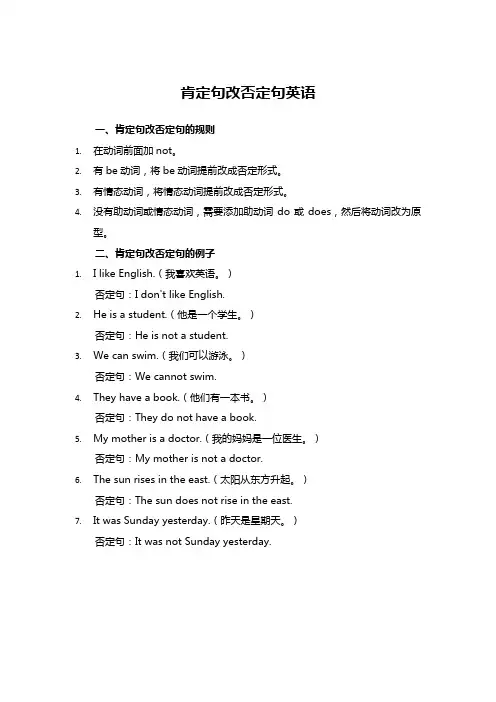
肯定句改否定句英语
一、肯定句改否定句的规则
1.在动词前面加not。
2.有be动词,将be动词提前改成否定形式。
3.有情态动词,将情态动词提前改成否定形式。
4.没有助动词或情态动词,需要添加助动词do或does,然后将动词改为原
型。
二、肯定句改否定句的例子
1.I like English.(我喜欢英语。
)
否定句:I don't like English.
2.He is a student.(他是一个学生。
)
否定句:He is not a student.
3.We can swim.(我们可以游泳。
)
否定句:We cannot swim.
4.They have a book.(他们有一本书。
)
否定句:They do not have a book.
5.My mother is a doctor.(我的妈妈是一位医生。
)
否定句:My mother is not a doctor.
6.The sun rises in the east.(太阳从东方升起。
)
否定句:The sun does not rise in the east.
7.It was Sunday yesterday.(昨天是星期天。
)
否定句:It was not Sunday yesterday.。
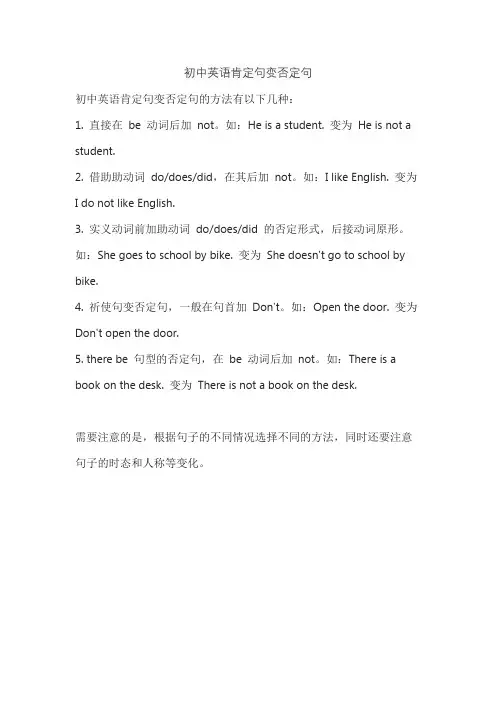
初中英语肯定句变否定句
初中英语肯定句变否定句的方法有以下几种:
1. 直接在be 动词后加not。
如:He is a student. 变为He is not a student.
2. 借助助动词do/does/did,在其后加not。
如:I like English. 变为
I do not like English.
3. 实义动词前加助动词do/does/did 的否定形式,后接动词原形。
如:She goes to school by bike. 变为She doesn't go to school by bike.
4. 祈使句变否定句,一般在句首加Don't。
如:Open the door. 变为Don't open the door.
5. there be 句型的否定句,在be 动词后加not。
如:There is a book on the desk. 变为There is not a book on the desk.
需要注意的是,根据句子的不同情况选择不同的方法,同时还要注意句子的时态和人称等变化。
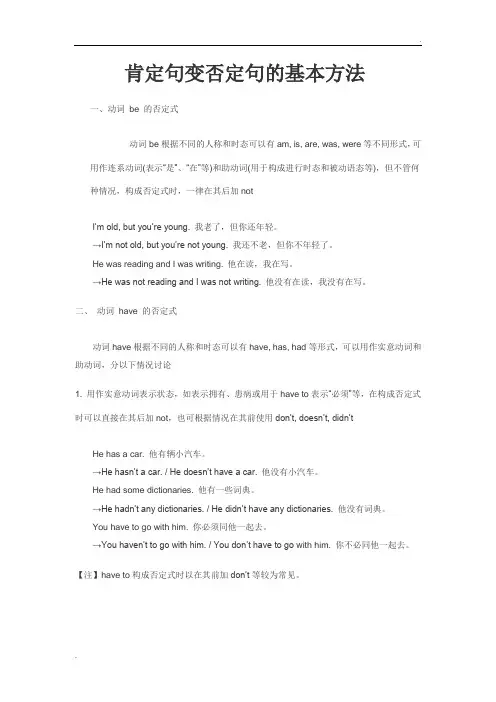
肯定句变否定句的基本方法一、动词be 的否定式动词be根据不同的人称和时态可以有am, is, are, was, were等不同形式,可用作连系动词(表示“是”、“在”等)和助动词(用于构成进行时态和被动语态等),但不管何种情况,构成否定式时,一律在其后加notI’m old, but you’re young. 我老了,但你还年轻。
→I’m not old, but you’re not young. 我还不老,但你不年轻了。
He was reading and I was writing. 他在读,我在写。
→He was not reading and I was not writing. 他没有在读,我没有在写。
二、动词have 的否定式动词have根据不同的人称和时态可以有have, has, had等形式,可以用作实意动词和助动词,分以下情况讨论1. 用作实意动词表示状态,如表示拥有、患病或用于have to表示“必须”等,在构成否定式时可以直接在其后加not,也可根据情况在其前使用don’t, doesn’t, didn’tHe has a car. 他有辆小汽车。
→He hasn’t a car. / He doesn’t have a car. 他没有小汽车。
He had some dictionaries. 他有一些词典。
→He hadn’t any dictionaries. / He didn’t have any dictionaries. 他没有词典。
You have to go with him. 你必须同他一起去。
→You haven’t to go with him. / You don’t have to go w ith him. 你不必同他一起去。
【注】have to构成否定式时以在其前加don’t等较为常见。
2. 用作实意动词表示动作,如表示“吃(=eat)”、“喝(=drink)”、“拿(=take)”、“收到(=receive)”、“度过(=spend)”等,构成否定式时不能直接在其后加not,而应根据情况在其前使用don’t, doesn’t, didn’tHe had some cake for breakfast. 他早餐吃了些蛋糕。
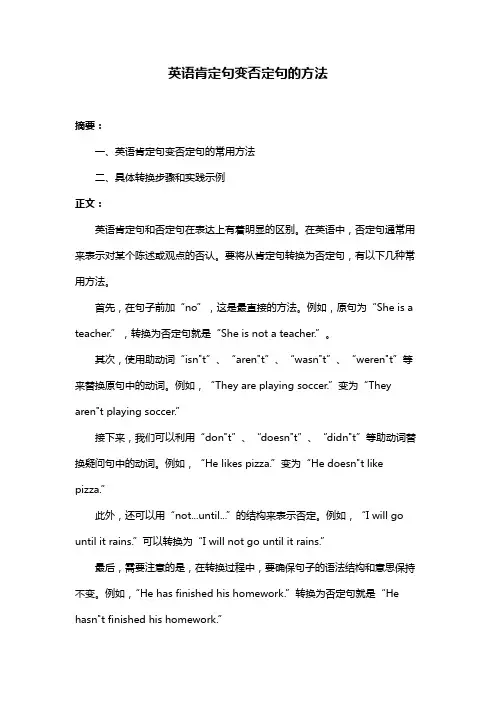
英语肯定句变否定句的方法摘要:一、英语肯定句变否定句的常用方法二、具体转换步骤和实践示例正文:英语肯定句和否定句在表达上有着明显的区别。
在英语中,否定句通常用来表示对某个陈述或观点的否认。
要将从肯定句转换为否定句,有以下几种常用方法。
首先,在句子前加“no”,这是最直接的方法。
例如,原句为“She is a teacher.”,转换为否定句就是“She is not a teacher.”。
其次,使用助动词“isn"t”、“aren"t”、“wasn"t”、“weren"t”等来替换原句中的动词。
例如,“They are playing soccer.”变为“They aren"t playing soccer.”接下来,我们可以利用“don"t”、“doesn"t”、“didn"t”等助动词替换疑问句中的动词。
例如,“He likes pizza.”变为“He doesn"t like pizza.”此外,还可以用“not...until...”的结构来表示否定。
例如,“I will go until it rains.”可以转换为“I will not go until it rains.”最后,需要注意的是,在转换过程中,要确保句子的语法结构和意思保持不变。
例如,“He has finished his homework.”转换为否定句就是“He hasn"t finished his homework.”总之,掌握以上方法,就可以轻松地将英语肯定句转换为否定句。
在实际应用中,根据不同的语境和句子结构,选择合适的方法进行转换,使句子更加丰富和生动。
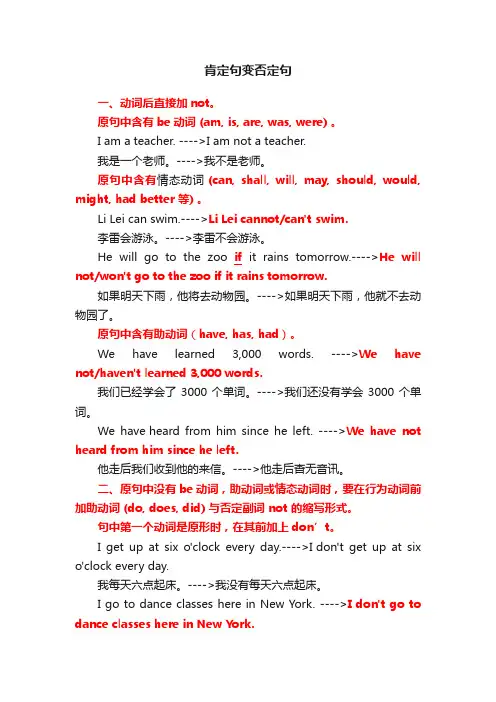
肯定句变否定句一、动词后直接加not。
原句中含有be动词 (am, is, are, was, were) 。
I am a teacher. ---->I am not a teacher.我是一个老师。
---->我不是老师。
原句中含有情态动词 (can, shall, will, may, should, would, might, had better 等) 。
Li Lei can swim.---->Li Lei cannot/can't swim.李雷会游泳。
---->李雷不会游泳。
He will go to the zoo if it rains tomorrow.---->He will not/won't go to the zoo if it rains tomorrow.如果明天下雨,他将去动物园。
---->如果明天下雨,他就不去动物园了。
原句中含有助动词(have, has, had)。
We have learned 3,000 words. ---->We have not/haven't learned 3,000 words.我们已经学会了3000个单词。
---->我们还没有学会3000个单词。
We have heard from him since he left. ---->We have not heard from him since he left.他走后我们收到他的来信。
---->他走后杳无音讯。
二、原句中没有be动词,助动词或情态动词时,要在行为动词前加助动词 (do, does, did) 与否定副词 not 的缩写形式。
句中第一个动词是原形时,在其前加上don’t。
I get up at six o'clock every day.---->I don't get up at six o'clock every day.我每天六点起床。
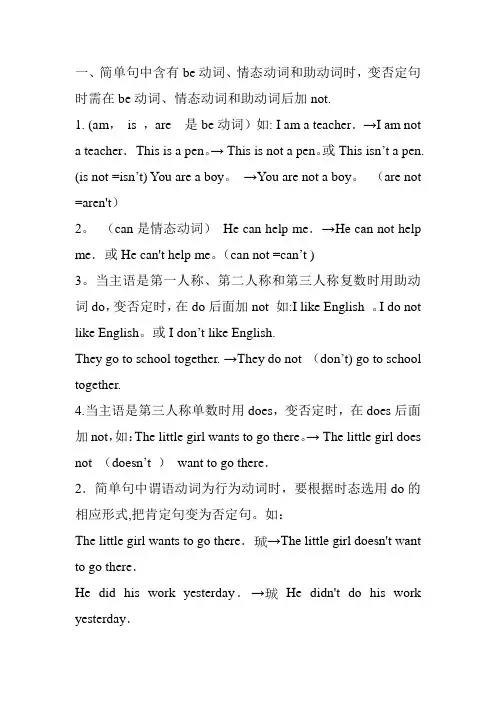
一、简单句中含有be动词、情态动词和助动词时,变否定句时需在be动词、情态动词和助动词后加not.1. (am,is ,are 是be动词)如: I am a teacher.→I am nota teacher.This is a pen。
→ This is not a pen。
或This isn’t a pen. (is not =isn’t) You are a boy。
→You are not a boy。
(are not =aren't)2。
(can是情态动词)He can help me.→He can not help me.或He can't help me。
(can not =can’t )3。
当主语是第一人称、第二人称和第三人称复数时用助动词do,变否定时,在do后面加not 如:I like English 。
I do not like English。
或I don’t like English.They go to school together. →They do not (don’t) go to school together.4.当主语是第三人称单数时用does,变否定时,在does后面加not,如:The little girl wants to go there。
→ The little girl does not (doesn’t )want to go there.2.简单句中谓语动词为行为动词时,要根据时态选用do的相应形式,把肯定句变为否定句。
如:The little girl wants to go there.→The little girl doesn't want to go there.He did his work yesterday.→He didn't do his work yesterday.3.祈使句变否定句时,一般在句首加Don't,但Let us或Let's 开头的祈使句在Let us或Let’s后加not也可。
一、肯定句改否定句的方法:1、在be动词后加not。
如:is not , are not ,am not, was not, were not;2、在can,should, will等后加not。
如:cannot,should not, will not;3、上述都没有的,在动词前加助动词否定形式don’t/doesn’t/didn’t。
4、 some 改成any。
如: I am a girl. → I am not a girl.You are a student. →You are not a student.→You aren’t a student.This is Tom’s bag, → This is not Tom’s bag.→ This isn’t Tom’s bag.答题方法是;否定词not在be后边。
二、肯定句改一般疑问句的方法:1、把be动词放在句首,剩下的照抄,(some 改成any,I改成you,my改成your,)句点改成问号。
2、把can,shall, will等放到句首,剩下的照抄,(some 改成any,I改成you,my改成your,)句点改成问号。
3、上述都没有的,在句首请助动词Do/Does/Did帮忙,剩下的照抄,(some 改成any,I改成you,my 改成your,)句点改成问号。
注意:句首的第一个字母要大写,句尾标点应为“?”。
如:I am in Class 6. →Are you in Class 6?You are from America. →Are you from America? It is an orange. →Is it an orange?答题方法是:要想提问,be提前,句末“?”别忘了。
4、就一般疑问句回答一般疑问句有两种回答,即:肯定回答和否定回答。
其中,肯定回答用yes,否定回答用no。
语句顺序为:Yes + 主语+ am /is/ are/was/were.|can.|do/does/did|; No + 主语+ am not/ isn’t/ aren’t/wasn't/weren't.|can't.|don't/doesn't/didn't |.。
1、You can use this dictionary.(改为否定句)You cannot(can’t)use this dictionary.2、There is some wonderful news in today’s paper.(改为否定句)There are any wonderful news in today’s paper.3、They play football on the playground.(改为一般疑问句,并作肯定回答)Do they play football on the playground?Yes, they do.4、This is my ID card.(改为一般疑问句)Is this your ID card?5、The schoolbag is under the desk.(改为一般疑问句,并作肯定回答)Is the schoolbag under the desk?Yes,it is.一、肯定句改否定句的方法:1、在be动词后加not。
如:is not ,are not ,am not,was not,were not;2、在can,should,will等后加not。
如:cannot,should not,will not;3、上述都没有的,在动词前加助动词否定形式don’t/doesn’t/didn’t。
4、some 改成any。
如:I am a girl. →I am not a girl.You are a student. →You are not a student.→You aren’t a student.This is Tom’s bag, →This is not Tom’s bag.→This isn’t Tom’s bag.答题方法是;否定词no t在be后边。
二、肯定句改一般疑问句的方法:1、把be动词放在句首,剩下的照抄,(some 改成any,I改成you,my改成your,)句点改成问号。
英语肯定句改为否定句口诀
以下是一些常见的英语肯定句改为否定句的口诀,帮助您快速掌握。
1.一般现在时
-肯定句:主语+动词原形
-否定句:主语+do/does not+动词原形
2.一般过去时
-肯定句:主语+动词过去式
-否定句:主语+did not+动词原形
3.一般将来时
-肯定句:主语+will+动词原形
-否定句:主语+will not/won't+动词原形
4.现在进行时
-肯定句:主语+am/is/are+动词-ing形式
-否定句:主语+am/is/are not+动词-ing形式
5.现在完成时
-肯定句:主语+have/has+过去分词
-否定句:主语+have/has not+过去分词
6.过去进行时
-肯定句:主语+was/were+动词-ing形式
-否定句:主语+was/were not+动词-ing形式
7.过去完成时
-肯定句:主语+had+过去分词
-否定句:主语+had not+过去分词
8.情态动词
-肯定句:主语+情态动词+动词原形
-否定句:主语+情态动词+not+动词原形
9.be动词(一般现在时)
-肯定句:主语+am/is/are
-否定句:主语+am/is/are not
10.be动词(一般过去时)
-肯定句:主语+was/were
-否定句:主语+was/were not
这些口诀可以帮助您快速记住肯定句改为否定句的基本规则。
然而,需要注意的是,有些特殊情况下,否定形式可能会有其他变化或使用不同的词汇。
因此,在具体应用时,仍需结合具体语境和语法规则进行判断和运用。
肯定句改为否定句的方法(1) 句中有be动词(am, is, are)和情态动词(can,would)的,直接在am, is, are, can, would的后面加not。
(2) 句中没有be动词(am, is, are)和情态动词(can,would)的,在动词前添加助动词don’t或doesn’t, 第三人称单数he\she\it\单名添加doesn’t, 加了doesn’t后,原句中的动词要变回原形。
(3) some改为any , and改为or。
1.I am a student.2.I’m going to the park.3.He is tall and strong.4.It’s on the chair.5.They’re under the tree.6.ZhangPeng is a university student.7.I can clean the bedroom.8.There are many trees in the forest.9.I’d like some beef and cabbage.10.Amy likes swimming in the sea.11.They are having a picnic in the woods.12.He has P.E. and art on Fridays.13.Mike is picking up leaves.14.I see two elephants.15.He gets up at 7:00 in the morning.16.There are some bridges in my village.17.My mother is very strict.18.He’d like some tofu for dinner.19.He does his homework and plays football on the weekends.20.Amy can clean the room.。
一、简单句中含有be动词、情态动词和助动词时,变否定句时需在be动词、情态动词和助动词后加not。
1. (am, is ,are 是be动词)如:I am a teacher.→I am nota teacher.This is a pen.→ This is not a pen.或This isn’t a pen. (is not =isn’t) You are a boy. →You are not a boy. (are not =aren’t)2. (can是情态动词)He can help me.→He can not help me.或He can’t help me.(can not =can’t )3.当主语是第一人称、第二人称和第三人称复数时用助动词do,变否定时,在do后面加not 如:I like English .I do not like English.或I don’t like English.They go to school together. →They do not (don’t) go to school together.4.当主语是第三人称单数时用does,变否定时,在does后面加not,如:The little girl wants to go there.→ The little girl does not (doesn't ) want to go there.2.简单句中谓语动词为行为动词时,要根据时态选用do的相应形式,把肯定句变为否定句。
如:The little girl wants to go there.→The little girl doesn't want to go there.He did his work yesterday.→He didn't do his work yesterday.3.祈使句变否定句时,一般在句首加Don't,但Let us或Let's 开头的祈使句在Let us或Let's后加not也可。
简单肯定句变否定句
简单肯定句指的是陈述一个事实或情况的句子,而简单否定句则是指否定这个事实或情况的句子。
下面介绍一些常见的简单肯定句变否定句的方法:
1. 在动词前加上否定词not。
例如:He is happy.(他很高兴。
)→ He is not happy.(他不高兴。
)
2. 使用否定形式的动词。
例如:She doesn't like coffee.(她不喜欢咖啡。
)
3. 使用否定的副词或形容词来修饰动词或名词,例如:The weather is not good.(天气不好。
)→ He is not very tall.(他不是很高。
)
需要注意的是,一些特殊的动词和形容词在否定时会有不同的形式,例如:
1. be动词的否定形式是not be。
例如:I am not hungry.(我不饿。
)
2. have动词的否定形式是do not have或have not。
例如:She does not have a car.(她没有车。
)
3. can动词的否定形式是cannot或can't。
例如:I cannot swim.(我不会游泳。
)
4. some和any的否定形式是no和none。
例如:There is no milk in the fridge.(冰箱里没有牛奶。
)
总之,掌握简单肯定句变否定句的方法是英语学习中的基础,需
要多加练习和记忆。
肯定句改为否定句
1.在am, is, are, have, has和can后加上not
肯定句改为一般疑问句
1.找到am, is, are, have, has和can,放到句首,注意大小写和标点符号。
2.I , we改为you my , our 改为your
肯定句用some, 否定句和一般疑问句用any.
肯定回答用Yes, 否定回答用No.
I have got a new bag.
否定句
一般疑问句
肯定回答
There is a book on the desk.
否定句
一般疑问句
否定回答
Tom can play pingpong.
否定句
一般疑问句
肯定回答
I am in the classroom.
否定句
一般疑问句
否定回答
1. This is a box.
否定句
一般疑问句
否定回答
2. These are Tom’s books.
否定句
一般疑问句
肯定回答
3. We are good friends.
否定句
一般疑问句
否定回答
4. They have got a football.
否定句
一般疑问句
肯定回答
5. She has got a cat.
否定句
一般疑问句
否定回答
6. I can make a card for my teacher. 否定句
一般疑问句
肯定回答。